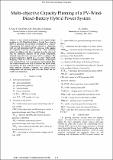| dc.contributor.author | Saif, A. | |
| dc.contributor.author | Elrab, Gad | |
| dc.contributor.author | Zeineldin, H. H. | |
| dc.contributor.author | Kennedy, Scott | |
| dc.contributor.author | Kirtley, James L., Jr. | |
| dc.date.accessioned | 2012-09-26T18:16:44Z | |
| dc.date.available | 2012-09-26T18:16:44Z | |
| dc.date.issued | 2010-12 | |
| dc.date.submitted | 2010-12 | |
| dc.identifier.isbn | 978-1-4244-9378-4 | |
| dc.identifier.uri | http://hdl.handle.net/1721.1/73193 | |
| dc.description.abstract | A new solution methodology of the capacity design problem of a PV-Wind-Diesel-Battery Hybrid Power System (HPS) is presented. The problem is formulated as a Linear Programming (LP) model with two objectives: minimizing total cost and minimizing total CO[subscript 2] emissions, while capping the Expected Unserved Energy (EUE). Total emissions include, in addition to the direct emissions from burning fossil fuel, the embedded emissions of all system components, obtained using Life Cycle Assessment (LCA) techniques. The proposed approach is applied on a case study which entails designing a HPS for a city of 50,000 residents. Model inputs were extracted from real environmental and technical data. The results obtained were used to construct the Pareto front, representing the best trade-off between cost and emissions under different reliability conditions. The optimal system configuration and operating plan were also found and the results were interpreted. | en_US |
| dc.language.iso | en_US | |
| dc.publisher | Institute of Electrical and Electronics Engineers (IEEE) | en_US |
| dc.relation.isversionof | http://dx.doi.org/10.1109/ENERGYCON.2010.5771679 | en_US |
| dc.rights | Article is made available in accordance with the publisher's policy and may be subject to US copyright law. Please refer to the publisher's site for terms of use. | en_US |
| dc.source | IEEE | en_US |
| dc.title | Multi-Objective Capacity Planning of a Pv-Wind-Diesel-Battery Hybrid Power System | en_US |
| dc.type | Article | en_US |
| dc.identifier.citation | Saif, A. et al. “Multi-objective Capacity Planning of a PV-wind-diesel-battery Hybrid Power System.” IEEE International Energy Conference and Exhibition (EnergyCon), 2010. 217–222. © Copyright 2010 IEEE | en_US |
| dc.contributor.department | Massachusetts Institute of Technology. Department of Electrical Engineering and Computer Science | en_US |
| dc.contributor.mitauthor | Kirtley, James L., Jr. | |
| dc.relation.journal | Proceedingsof the IEEE International Energy Conference and Exhibition (EnergyCon), 2010 | en_US |
| dc.eprint.version | Final published version | en_US |
| dc.type.uri | http://purl.org/eprint/type/ConferencePaper | en_US |
| dspace.orderedauthors | Saif, A.; Elrab, K. Gad; Zeineldin, H. H.; Kennedy, S.; Kirtley, J. L. | en |
| dc.identifier.orcid | https://orcid.org/0000-0002-5347-2410 | |
| mit.license | PUBLISHER_POLICY | en_US |
| mit.metadata.status | Complete | |
